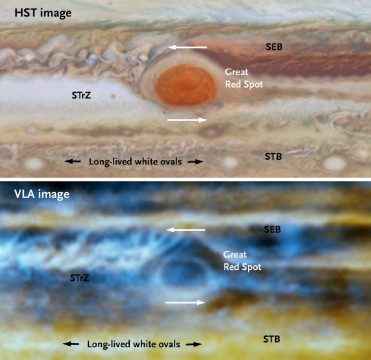
Visible: NASA; Radio: Imke de Pater et al. / NRAO / AUI / NSF
Astronomers have new radio images of Jupiter that allow them to see deep into its atmosphere.
Scientists using the Very Large Array (VLA) now have an unprecedented deep look into Jupiter’s atmosphere, after probing planet’s cloud layers to depths of about 100 km. These new images give scientists detail that was unavailable before and information about the atmosphere’s temperature, pressure, and gas motions.
To make sensitive radio images, multi-antenna telescopes — like VLA — need to gather emitted radio waves for a long period of time, much like a time exposure on a camera. Yet because Jupiter rotates so quickly, in less than 10 hours, conventional radio images would be smeared in just a few minutes.
To overcome this, researchers took advantage of VLA’s upgraded sensitivity and developed an innovative data-reduction technique to “unsmear” the data from many hours of observation. Their results, published in the June 3rd issue of Science, give new insights to the structure and dynamics of the planet’s atmosphere.
Researchers compared maps of Jupiter as seen at different radio wavelengths to visible-light images made at nearly the same time. The giant planet’s familiar light-colored zones and darker belts generally correlate well with the radio features, but the new radio images showed some radio-bright details unconnected to visible-light features.
These locations mark where an overlying layer of ammonia (NH3) is thin, making the atmosphere more transparent at radio wavelengths and allowing a peek at depths where the temperature is higher and the pressure up to 8 times greater than at sea level on Earth. The VLA images reveal evidence of what scientists think are rising plumes of gas that are part of the wave patterns that produce hot spots previously observed by infrared-sensitive telescopes.
“All told, there is a wealth of information about the structure of Jupiter’s atmosphere in these new VLA images,” said Imke de Pater (University of California, Berkeley).
 1
1









Comments
Bob
June 9, 2016 at 12:41 am
Ana...
Thank you for this interesting article about the Very Large Array radio probe into Jupiter's atmosphere. The comparison of the Hubble Space Telescope image with the Very Large Array radio image is very illuminating.
And let me add that I enjoy your writing style.
...Bob
You must be logged in to post a comment.
You must be logged in to post a comment.